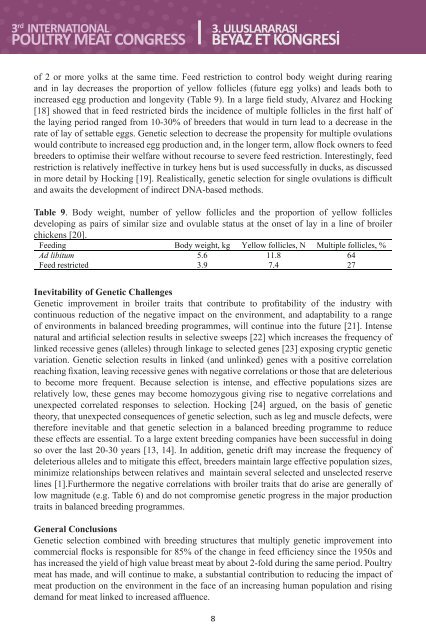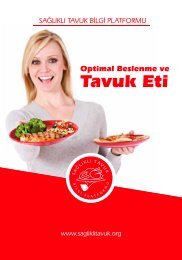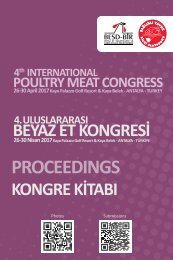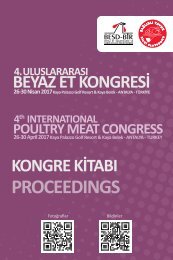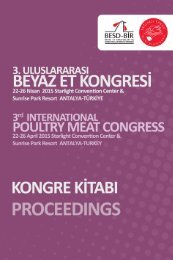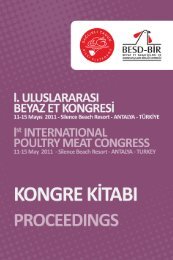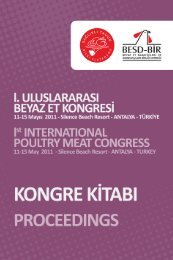3rd International Poultry Meat Congress
Proceedings
Proceedings
Create successful ePaper yourself
Turn your PDF publications into a flip-book with our unique Google optimized e-Paper software.
of 2 or more yolks at the same time. Feed restriction to control body weight during rearing<br />
and in lay decreases the proportion of yellow follicles (future egg yolks) and leads both to<br />
increased egg production and longevity (Table 9). In a large field study, Alvarez and Hocking<br />
[18] showed that in feed restricted birds the incidence of multiple follicles in the first half of<br />
the laying period ranged from 10-30% of breeders that would in turn lead to a decrease in the<br />
rate of lay of settable eggs. Genetic selection to decrease the propensity for multiple ovulations<br />
would contribute to increased egg production and, in the longer term, allow flock owners to feed<br />
breeders to optimise their welfare without recourse to severe feed restriction. Interestingly, feed<br />
restriction is relatively ineffective in turkey hens but is used successfully in ducks, as discussed<br />
in more detail by Hocking [19]. Realistically, genetic selection for single ovulations is difficult<br />
and awaits the development of indirect DNA-based methods.<br />
Table 9. Body weight, number of yellow follicles and the proportion of yellow follicles<br />
developing as pairs of similar size and ovulable status at the onset of lay in a line of broiler<br />
chickens [20].<br />
Feeding Body weight, kg Yellow follicles, N Multiple follicles, %<br />
Ad libitum 5.6 11.8 64<br />
Feed restricted 3.9 7.4 27<br />
<br />
Inevitability of Genetic Challenges<br />
Genetic improvement in broiler traits that contribute to profitability of the industry with<br />
continuous reduction of the negative impact on the environment, and adaptability to a range<br />
of environments in balanced breeding programmes, will continue into the future [21]. Intense<br />
natural and artificial selection results in selective sweeps [22] which increases the frequency of<br />
linked recessive genes (alleles) through linkage to selected genes [23] exposing cryptic genetic<br />
variation. Genetic selection results in linked (and unlinked) genes with a positive correlation<br />
reaching fixation, leaving recessive genes with negative correlations or those that are deleterious<br />
to become more frequent. Because selection is intense, and effective populations sizes are<br />
relatively low, these genes may become homozygous giving rise to negative correlations and<br />
unexpected correlated responses to selection. Hocking [24] argued, on the basis of genetic<br />
theory, that unexpected consequences of genetic selection, such as leg and muscle defects, were<br />
therefore inevitable and that genetic selection in a balanced breeding programme to reduce<br />
these effects are essential. To a large extent breeding companies have been successful in doing<br />
so over the last 20-30 years [13, 14]. In addition, genetic drift may increase the frequency of<br />
deleterious alleles and to mitigate this effect, breeders maintain large effective population sizes,<br />
minimize relationships between relatives and maintain several selected and unselected reserve<br />
lines [1].Furthermore the negative correlations with broiler traits that do arise are generally of<br />
low magnitude (e.g. Table 6) and do not compromise genetic progress in the major production<br />
traits in balanced breeding programmes.<br />
General Conclusions<br />
Genetic selection combined with breeding structures that multiply genetic improvement into<br />
commercial flocks is responsible for 85% of the change in feed efficiency since the 1950s and<br />
has increased the yield of high value breast meat by about 2-fold during the same period. <strong>Poultry</strong><br />
meat has made, and will continue to make, a substantial contribution to reducing the impact of<br />
meat production on the environment in the face of an increasing human population and rising<br />
demand for meat linked to increased affluence.<br />
8


